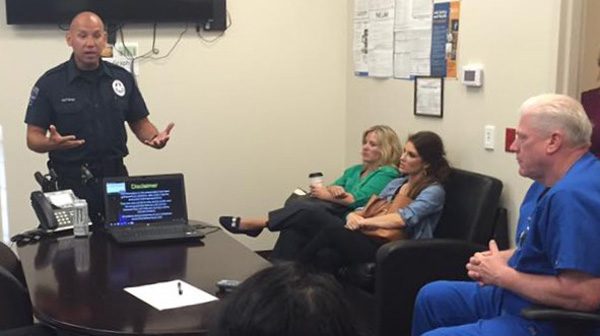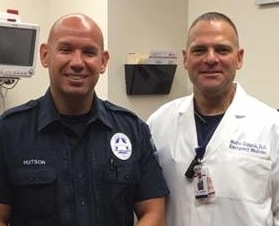
Ongoing training for the unexpected is an integral part of any emergency department, particularly with workplace gun violence being a nationwide concern. Recently, Family ER + Urgent Care in Irving, Texas, hosted Officer David Hutson of the Irving Police Department SWAT Team. Mr. Hutson provided an informative presentation titled “Active Shooter: Recognize, Respond, Prepare, and Prevent.” The information he gave us was so good that we wanted to share the highlights with ACEP Now readers.
Recognize Potential Violence: “Don’t Ignore It, and Follow Your Instincts”
In the event of an active-shooter situation, Mr. Hutson outlined the following steps:
- If it’s safe to do so, dial 911 to inform police of the situation.
- If you’re unable to speak, leave the phone off of the hook and escape, if possible.
- If escape isn’t possible, barricade yourself in a room. Use everything and anything to block access to the shooter—chairs, refrigerators, tables, desks, stretchers, TVs, etc.
- If you have no choice but to confront the assailant, be aggressive: Yell and FIGHT!
Shooting Back: Advice for License-to-Carry Holders
Some states allow either concealed carry or open carry. Some medical facilities in Texas have signs posted stating that no one can carry into the facility either open or concealed. But in many of those facilities, there are internal policies allowing staff members to carry, open or concealed. Because Family ER + Urgent Care is in Texas, Mr. Hutson made special recommendations for those with a license to carry:
- If you’re carrying a firearm and are under immediate threat in the area where you are sheltering in place, take action.
- Commit to your actions and take as accurate a shot as possible. (According to Mr. Hutson, the vast majority of assailants will commit suicide if confronted with equal or greater force.)
- If the assailant is subdued, do not leave your shelter place with your weapon. Police may think you are also an active shooter.
Working with Police: Be Measured and Follow Directions
When police arrive, Mr. Hutson recommended these actions for all personnel in the facility:
- Do not run toward the police; they don’t know who you are.
- Follow their directions exactly.
- Only tell police what you truly know—don’t elaborate.
- If you’re medically trained and are rendering aid to others, follow police instructions, despite a patient’s condition. They have a better handle on how secure the area is.
Be Ready: Preventing Workplace Violence and Active-Shooter Damage
Pages: 1 2 | Single Page



No Responses to “Expecting the Unexpected: Prepare for Active-shooter Situations in the Emergency Department”